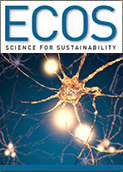
|
Published: 19 May 2014
Gene ‘poaching’ the secret to eucalypt resilience?
Despite what most people think, identifying eucalypts is no easy task. A tree that may look like an alpine ash might also harbour genes more commonly found in a mountain ash tree downslope. In fact, this tendency of eucalypts to readily ‘poach’ genes from related species may hold the key to their survival in a rapidly changing climate.
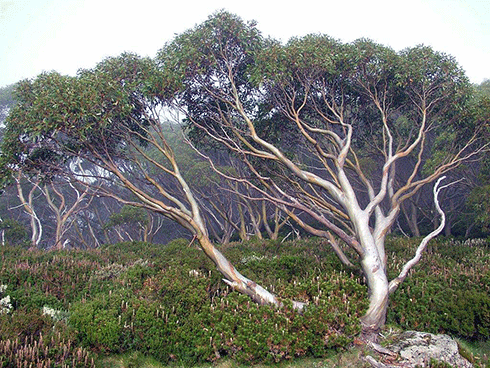
|
|
Snow gum (Eucalyptus pauciflora): Different eucalypt species have adapted to diverse environments across Australia. How will current species distributions respond to climate change? Credit:
A. Crowe
|
Unlike most plant and animal species – where the DNA sequences of two different individuals from the same species will be similar – eucalypts have high levels of hybridisation. A first-generation hybrid might be easy to spot, because it combines features of two species.
However, if that tree breeds with a parent species, subsequent generations of hybrids will be hard to identify with the naked eye – they will look convincingly like the parent species. Not until you delved into the hybrids’ genetic makeup would you find sections of ‘poached’ genetic material that might, at first, appear to belong to the wrong species.
University of Melbourne Masters student, Alice Crowe, is researching eucalypt DNA sequences from mountain ash, alpine ash, snow gums and related species at five field sites in Victoria. She is trying to determine whether visual differences between species are matched by differences at a genetic level.
Surprisingly, previous research provides little evidence of genetic differentiation between closely related eucalypt species. Alice thinks that the evidence for gene poaching challenges the current basis for defining separate eucalypt species.
‘It might sound dramatic, but we’re really poking around in our ideas of what we call a species,’ Alice says.
‘If there’s no way to tell one species from another at a genetic level, what have we got? Lots of different species, or just a big pool of genes that manifest differently in different places?
‘With this project, we’re hoping to provide genetic tools to identify different eucalypt species – or at least determine whether that’s possible.’
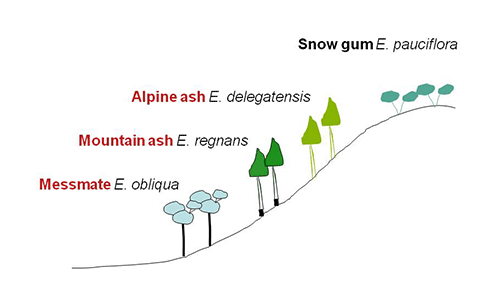
|
|
The typical altitudinal sequence of the four eucalypt species studied. Credit:
A. Crowe
|
Although such research was purely theoretical just a few years ago, rapid advances in DNA ‘barcoding’ have revolutionised taxonomy – the science of describing and naming different species.
With DNA barcoding, scientists can take a tiny sample of cells from an organism, run it through hi-tech machines, and compare the resulting gene sequence with a database to identify what they’re looking at. It’s far more convenient than conventional classification techniques that require a complete plant or animal for specimen identification.
For hybridised plants such as eucalypts, however, DNA barcoding is not as straightforward. Alice is hopeful that a solution may lie in the DNA of the cell nucleus, which contains the cell’s chromosomes, rather than in the DNA of chloroplasts – smaller intra-cellular components that contain chlorophyll, the green-coloured pigment that catalyses photosynthesis.
‘Quite a lot is known about gene swapping in eucalypts at the chloroplast level, based on comparisons of small fragments of chloroplast genes. There are few studies at the level of the cell nucleus.
‘We'll be delving much deeper by comparing sequences of whole chloroplast genomes and a broad sample of DNA in the cell nucleus.’
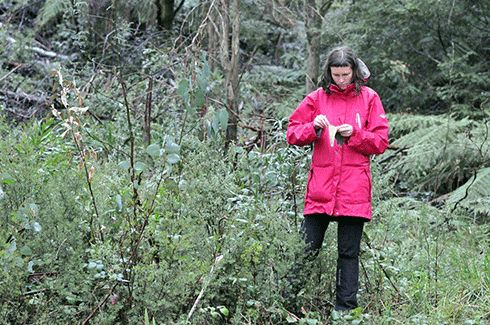
|
|
Alice Crowe collects leaf samples in the field. Credit:
A. Crowe
|
When she’s not out in the bush collecting leaves from a 40 metre tall eucalypt with a slingshot, Alice is in the lab, grinding up leaf and cambial (trunk) samples to isolate the DNA, which is then sheared into pieces using sound waves or enzymes.
A molecular ‘tag’ is then bound to each DNA fragment to identify the source tree. DNA from many different trees is put into the one tube and sent away for genome sequencing. What comes back is like a vast and complicated jigsaw puzzle: a series of partial sequences, each symbolised by a string of letters.
Alice’s research group uses the molecular tags to work out which pieces of the ‘puzzle’ come from which sample, so they can piece together the genome for each individual tree.
The resultant database of samples from different species will be used to analyse the extent of gene swapping at each of the five field sites. The researchers want to know whether gene sharing is more prevalent at some sites, as well as the extent of any genetically fixed differences between species.
Alice thinks the gene swapping demonstrated by eucalypts is potentially evolution-in-action. As conditions on a mountainside change, populations of trees might be borrowing the genes they need to survive.
Understanding the extent of this genetic adaptation could help us understand the potential of eucalypts to cope with a changing climate. As warmer temperatures creep further up the slopes, how much flexibility will affected species have to adapt and survive?
The degree of genetic diversity within a single species could also affect how areas are marked for conservation. If stands of alpine ash at one site are genetically different from those at another, should we aim to conserve examples of both, or is it enough to protect habitat for ‘the species’ as a whole?
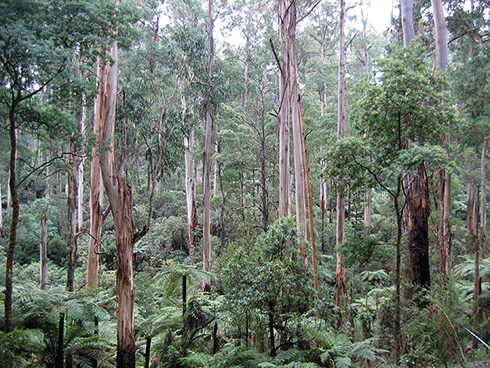
|
|
Who knows what eucalypt genes might lurk in this stand of mountain ash? Credit:
Patche99z
|
Alice has gone out on a limb to pursue a career in taxonomy. She spent 10 years as a litigation lawyer before deciding to pursue her passion for the natural world.
‘The chance to get out there doing field work is what life’s really about. I loved law, but this gives me a chance to unleash my curiosity and find out more about the kind of universe we live in.
‘People seem to think that science has already discovered everything there is to know about the world around us, but that couldn’t be further from the truth.’
Alice is being guided in her work by retired eucalypt taxonomist, Professor Pauline Ladiges, and University of Melbourne and Royal Botanic Gardens Melbourne senior researchers, Dr Mike Bayly and Dr Frank Udovicic.
‘There’s a whole generation of knowledge tied up in people like Mike, Frank and Pauline, and it’s crucial that we keep passing that experience down,’ Alice says.
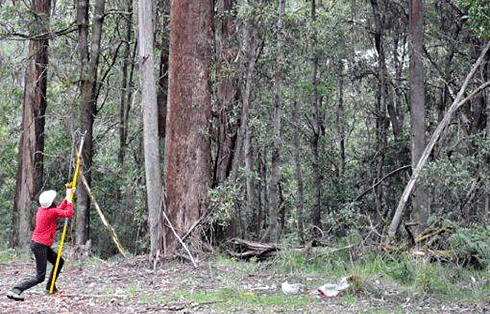
|
|
Using a slingshot to collect samples from the tallest trees. Credit:
A. Crowe
|
Alice’s project is backed up by a $10,000 grant from the Australian Government, through the Australian Biological Resources Study. The grants aim to support a new generation of scientists to launch careers in taxonomy.
Senator Simon Birmingham, the Parliamentary Secretary to the Minister for the Environment, is a keen supporter of the grants.
‘It’s vital to build a new generation of Australian taxonomists, so as the profession evolves we don’t lose our national knowledge base,’ says Senator Birmingham.
‘Without taxonomists, whole elements of Australian industry, agriculture and environmental management would be compromised, so these young scientists are well worth the investment.’


